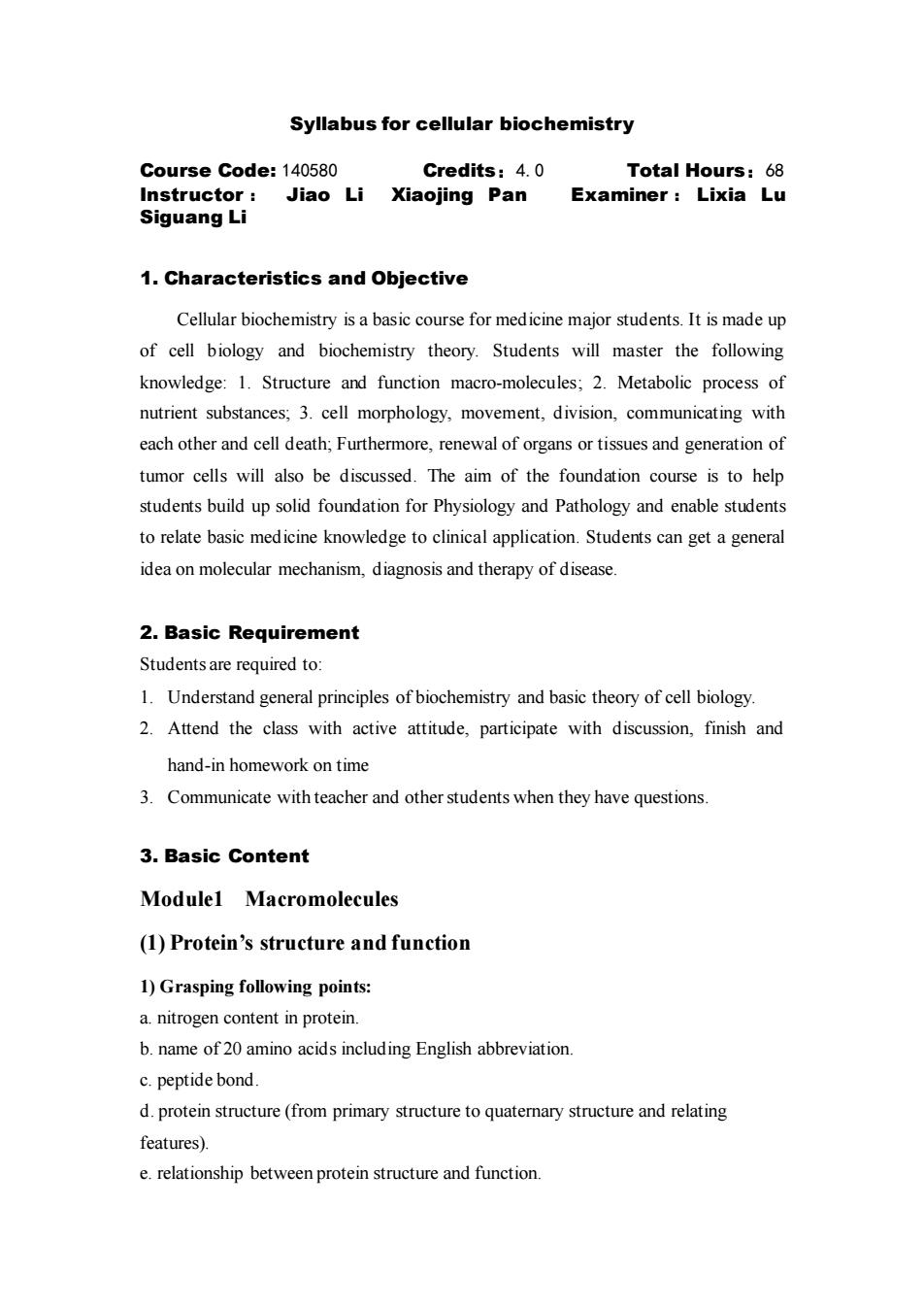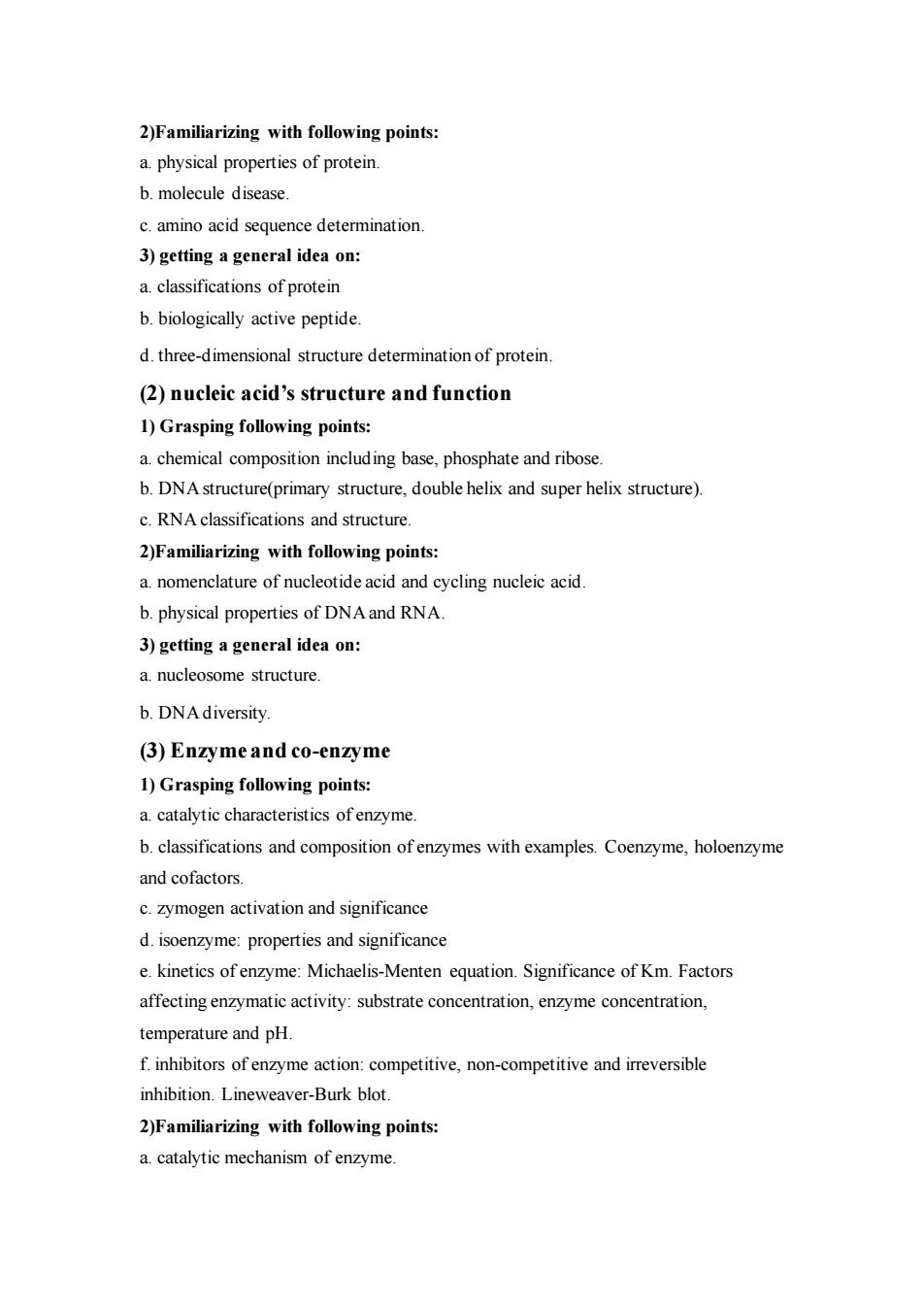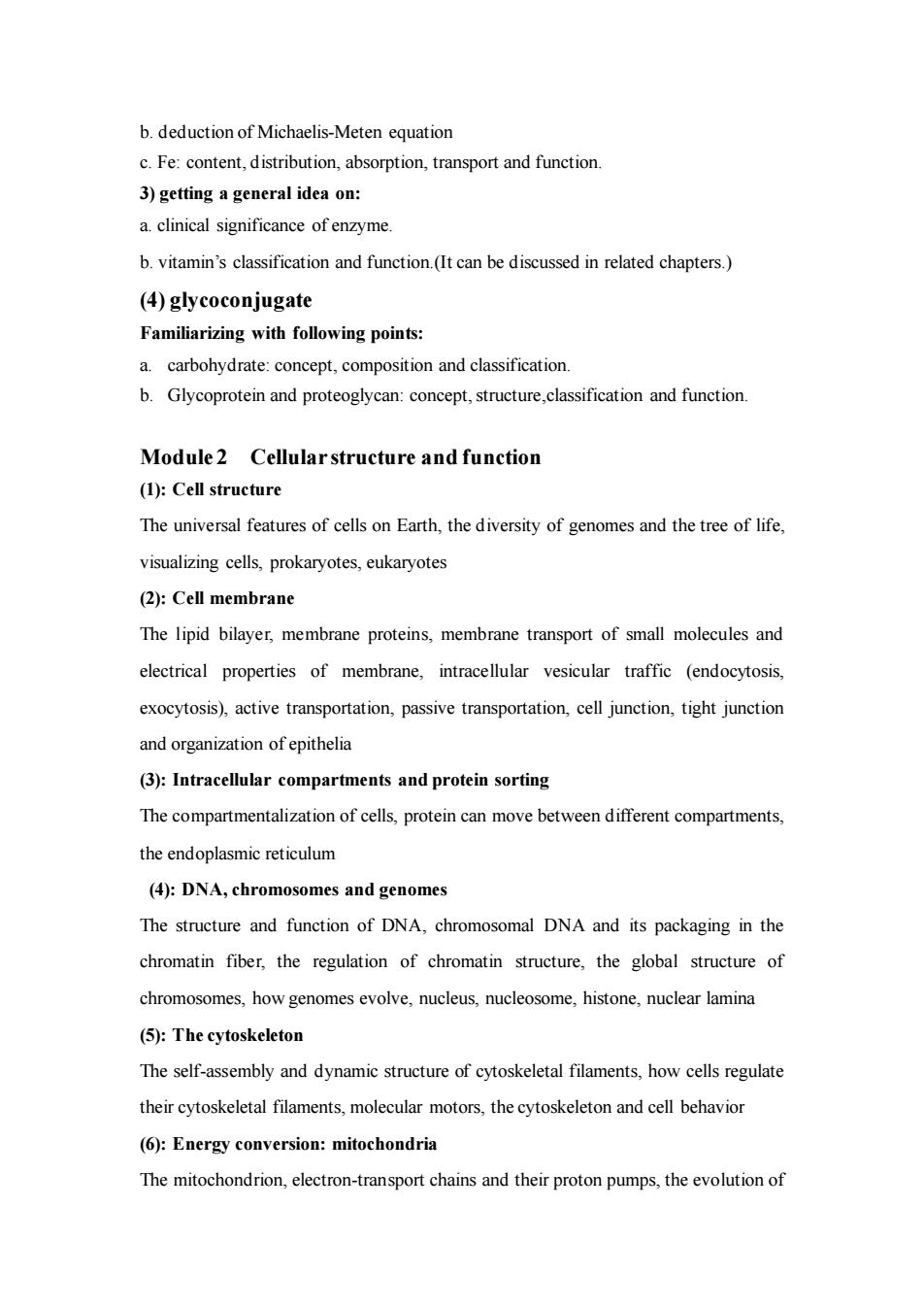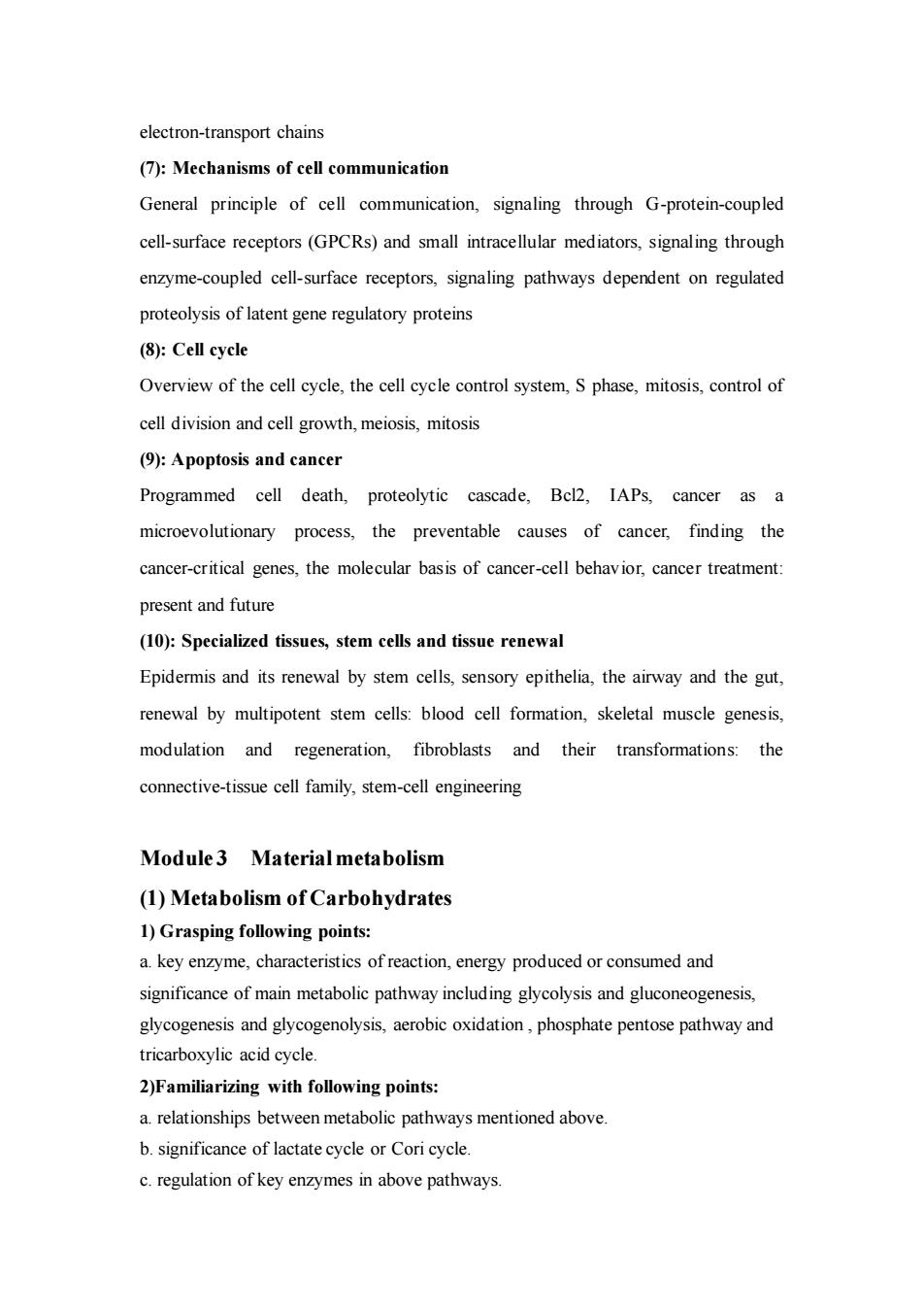
Syllabus for cellular biochemistry Course Code:140580 Credits:4.0 Total Hours:68 Jiao Li Xiaojing Pan Examiner:Lixia Lu 1.Characteristics and Objective Cellular biochemistry is a basic course for medicine major students.It is made up of cell biology and biochemistry theory.Students will master the following knowledge:1.Structure and function macro-molecules:2.Metabolic process of nutrient substances:3.cell morphology,movement,division,communicating with each other and cell death;Furthermore,renewal of organs or tissues and generation of tumor cells will also be discussed.The aim of the foundation course is to help students build up solid foundation for Physiology and Pathology and enable students to relate basic medicine knowledge to clinical application.Students can get a general idea on molecular mechanism,diagnosis and therapy of disease. 2.Basic Requirement Studentsare required to: 1.Understand general principles of biochemistry and basic theory of cell biology. 2.Attend the class with active attitude,participate with discussion,finish and hand-in homework on time 3.Communicate with teacher and other students when they have questions. 3.Basic Content Modulel Macromolecules (1)Protein's structure and function 1)Grasping following points: a.nitrogen content in protein. b.name of20 amino acids including English abbreviation c.peptide bond. d.protein structure(from primary structure to quaternary structure and relating features). e.relationship between protein structure and function
Syllabus for cellular biochemistry Course Code: 140580 Credits:4.0 Total Hours:68 Instructor : Jiao Li Xiaojing Pan Examiner : Lixia Lu Siguang Li 1. Characteristics and Objective Cellular biochemistry is a basic course for medicine major students. It is made up of cell biology and biochemistry theory. Students will master the following knowledge: 1. Structure and function macro-molecules; 2. Metabolic process of nutrient substances; 3. cell morphology, movement, division, communicating with each other and cell death; Furthermore, renewal of organs or tissues and generation of tumor cells will also be discussed. The aim of the foundation course is to help students build up solid foundation for Physiology and Pathology and enable students to relate basic medicine knowledge to clinical application. Students can get a general idea on molecular mechanism, diagnosis and therapy of disease. 2. Basic Requirement Students are required to: 1. Understand general principles of biochemistry and basic theory of cell biology. 2. Attend the class with active attitude, participate with discussion, finish and hand-in homework on time 3. Communicate with teacher and other students when they have questions. 3. Basic Content Module1 Macromolecules (1) Protein’s structure and function 1) Grasping following points: a. nitrogen content in protein. b. name of 20 amino acids including English abbreviation. c. peptide bond. d. protein structure (from primary structure to quaternary structure and relating features). e. relationship between protein structure and function

2)Familiarizing with following points: a.physical properties of protein b.molecule disease c.amino acid sequence determination 3)getting a general idea on: a.classifications of protein b.biologically active peptide. d.three-dimensional structure determination of protein. (2)nucleic acid's structure and function 1)Grasping following points: a.chemical composition including base,phosphate and ribose b.DNAstructure(primary structure,double helix and super helix structure). c.RNA classifications and structure. 2)Familiarizing with following points: a nomenclature of nucleotideacid and cycling acid b.physical properties of DNAand RNA. 3)getting a general idea on: a.nucleosome structure b.DNAdiversity (3)Enzymeand co-enzyme 1)Grasping following points: a.catalytic characteristics ofenzyme b.classifications and composition of enzymes with examples.Coenzyme,holoenzyme and cofactors. c.zymogen activation and significance d.isoenzyme:properties and significance e.kinetics ofenzyme:Michaelis-Menten equation.Significance of Km.Factors affecting enzymatic activity:substrate concentration,enzyme concentration. temperature and pH. f.inhibitors of enzyme action:competitive,non-competitive and irreversible inhibition.Lineweaver-Burk blot 2)Familiarizing with following points a.catalytic mechanism of enzyme
2)Familiarizing with following points: a. physical properties of protein. b. molecule disease. c. amino acid sequence determination. 3) getting a general idea on: a. classifications of protein b. biologically active peptide. d. three-dimensional structure determination of protein. (2) nucleic acid’s structure and function 1) Grasping following points: a. chemical composition including base, phosphate and ribose. b. DNA structure(primary structure, double helix and super helix structure). c. RNA classifications and structure. 2)Familiarizing with following points: a. nomenclature of nucleotide acid and cycling nucleic acid. b. physical properties of DNA and RNA. 3) getting a general idea on: a. nucleosome structure. b. DNA diversity. (3) Enzyme and co-enzyme 1) Grasping following points: a. catalytic characteristics of enzyme. b. classifications and composition of enzymes with examples. Coenzyme, holoenzyme and cofactors. c. zymogen activation and significance d. isoenzyme: properties and significance e. kinetics of enzyme: Michaelis-Menten equation. Significance of Km. Factors affecting enzymatic activity: substrate concentration, enzyme concentration, temperature and pH. f. inhibitors of enzyme action: competitive, non-competitive and irreversible inhibition. Lineweaver-Burk blot. 2)Familiarizing with following points: a. catalytic mechanism of enzyme

b.deduction of Michaelis-Meten equation c.Fe:content,distribution,absorption,transport and function 3)getting a general idea on a.clinical significance of enzyme b.vitamin's classification and function.(It can be discussed in related chapters.) (4)glycoconjugate Familiarizing with following points: a.carbohydrate:concept,composition and classification. b.Glycoprotein and proteoglycan:concept,structure,classification and function Module2 Cellularstructure and function (1):Cell structure The universal features of cells on Earth,the diversity of genomes and the tree of life, visualizing cells,prokaryotes,eukaryotes (2):Cell membrane The lipid bilayer,membrane proteins,membrane transport of small molecules and electrical properties of membrane,intracellular vesicular traffic (endocytosis. exocytosis),active transportation,passive transportation,cell junction,tight junction and organization of epithelia (3):Intracellular compartments and protein sorting The compartmentalization of cells protein can move between different compartments. the endoplasmic reticulum (4):DNA,chromosomes and genomes The structure and function of DNA,chromosomal DNA and its packaging in the chromatin fiber,the regulation of chromatin structure.the global structure of chromosomes,how genomes evolve,nucleus,nucleosome,histone,nuclear lamina (⑤):The cytoskeleton The self-assembly and dynamic structure of cytoskeletal filaments,how cells regulate their cytoskeletal filaments,molecular motors,the cytoskeleton and cell behavior (⑥):Energy conversion:mitochondria The mitochondrion,electron-transport chains and their proton pumps,the evolution of
b. deduction of Michaelis-Meten equation c. Fe: content, distribution, absorption, transport and function. 3) getting a general idea on: a. clinical significance of enzyme. b. vitamin’s classification and function.(It can be discussed in related chapters.) (4) glycoconjugate Familiarizing with following points: a. carbohydrate: concept, composition and classification. b. Glycoprotein and proteoglycan: concept, structure,classification and function. Module 2 Cellular structure and function (1): Cell structure The universal features of cells on Earth, the diversity of genomes and the tree of life, visualizing cells, prokaryotes, eukaryotes (2): Cell membrane The lipid bilayer, membrane proteins, membrane transport of small molecules and electrical properties of membrane, intracellular vesicular traffic (endocytosis, exocytosis), active transportation, passive transportation, cell junction, tight junction and organization of epithelia (3): Intracellular compartments and protein sorting The compartmentalization of cells, protein can move between different compartments, the endoplasmic reticulum (4): DNA, chromosomes and genomes The structure and function of DNA, chromosomal DNA and its packaging in the chromatin fiber, the regulation of chromatin structure, the global structure of chromosomes, how genomes evolve, nucleus, nucleosome, histone, nuclear lamina (5): The cytoskeleton The self-assembly and dynamic structure of cytoskeletal filaments, how cells regulate their cytoskeletal filaments, molecular motors, the cytoskeleton and cell behavior (6): Energy conversion: mitochondria The mitochondrion, electron-transport chains and their proton pumps, the evolution of

electron-transport chains (7):Mechanisms of cell communication General principle of cell communication,signaling through G-protein-coupled cell-surface receptors(GPCRs)and small intracellular mediators,signaling through enzyme-coupled cell-surface receptors,signaling pathways dependent on regulated proteolysis of latent gene regulatory proteins (8):Cell eycle Overview of the cell cycle,the cell cycle control system,S phase,mitosis,control of cell division and cell growth,meiosis,mitosis (9:片Apoptosis and cancer Programmed cell death,proteolytic cascade,Bel2,IAPs,cancer as a microevolutionary process,the preventable causes of cancer,finding the cancer-critical genes,the molecular basis of cancer-cell behavior,cancer treatment: present and future (10):Specialized tissues,stem cells and tissue renewal Epidermis and its renewal by stem cells,sensory epithelia,the airway and the gut, renewal by multipotent stem cells:blood cell formation,skeletal muscle genesis. modulation and regeneration,fibroblasts and their transformations:the connective-tissue cell family,stem-cell engineering Module3 Material metabolism (1)Metabolism of Carbohydrates 1)Grasping following points: a.key enzyme,characteristics ofreaction,energy produced or consumed and significance of main metabolic pathway including glycolysis and gluconeogenesis, glycogenesis and glycogenolysis,aerobic oxidation,phosphate pentose pathway and tricarboxylic acid cycle. 2)Familiarizing with following points: a.relationships between metabolic pathways mentioned above. b.significance of lactate cycle or Cori cycle. c.regulation of key enzymes in above pathways
electron-transport chains (7): Mechanisms of cell communication General principle of cell communication, signaling through G-protein-coupled cell-surface receptors (GPCRs) and small intracellular mediators, signaling through enzyme-coupled cell-surface receptors, signaling pathways dependent on regulated proteolysis of latent gene regulatory proteins (8): Cell cycle Overview of the cell cycle, the cell cycle control system, S phase, mitosis, control of cell division and cell growth, meiosis, mitosis (9): Apoptosis and cancer Programmed cell death, proteolytic cascade, Bcl2, IAPs, cancer as a microevolutionary process, the preventable causes of cancer, finding the cancer-critical genes, the molecular basis of cancer-cell behavior, cancer treatment: present and future (10): Specialized tissues, stem cells and tissue renewal Epidermis and its renewal by stem cells, sensory epithelia, the airway and the gut, renewal by multipotent stem cells: blood cell formation, skeletal muscle genesis, modulation and regeneration, fibroblasts and their transformations: the connective-tissue cell family, stem-cell engineering Module 3 Material metabolism (1) Metabolism of Carbohydrates 1) Grasping following points: a. key enzyme, characteristics of reaction, energy produced or consumed and significance of main metabolic pathway including glycolysis and gluconeogenesis, glycogenesis and glycogenolysis, aerobic oxidation , phosphate pentose pathway and tricarboxylic acid cycle. 2)Familiarizing with following points: a. relationships between metabolic pathways mentioned above. b. significance of lactate cycle or Cori cycle. c. regulation of key enzymes in above pathways

d.origin and metabolic pathway of blood sugar.Regulation and significance of blood sugar 3)getting a general idea on: a.digestion and absorption of carbohydrates. b.non-oxidative phase of PPP (2)Metabolism of Lipids 1)Grasping following points: a.synthesis and degradation of triglyceride.B-oxidation of even carbon atom fatty acids.Synthesis and transport of R-CoSCoA b.formation,degradation and significance of ketone bodies c.classifications and functions of phospholipids. d.biosynthesis(key enzyme)and biotransformation of cholesterol e.plasma lipoprotein:classifications,composition and function. 2)Familiarizing with following points: a.digestion and absorption of lipids b.synthesis of fatty acid:location,substrates,ATP,key enzyme and regulation. c.apolipoprotein:classifications and functions. 3)getting a general idea on: a.extension of fatty acid chain. b.synthesis of unsaturated and derivatives of polyunsaturated fatty acids. c.a and oxidation of fatty acids d.hyperlipemia (3)biologicaloxidation 1)Grasping following points: a.biological oxidation:concept,characteristics and significance. b.mitochondrial respiratory chain:organization,sequence and function. c.oxidative phosphorylation:sites ofATP formation,ATP synthase,inhibitors and uncouplers. 2)Familiarizing with following points: a.chemiosmotic hypothesis. b.a-glycerophosphate shuttle and malate-aspartate shuttle. .generation and disposal of superoxide radicals and enzymes involved 3)getting a general idea on:
d. origin and metabolic pathway of blood sugar. Regulation and significance of blood sugar. 3) getting a general idea on: a. digestion and absorption of carbohydrates. b. non-oxidative phase of PPP. (2) Metabolism of Lipids 1) Grasping following points: a. synthesis and degradation of triglyceride. β- oxidation of even carbon atom fatty acids. Synthesis and transport of R-CoSCoA. b. formation , degradation and significance of ketone bodies. c. classifications and functions of phospholipids. d. biosynthesis(key enzyme) and biotransformation of cholesterol. e. plasma lipoprotein: classifications, composition and function. 2)Familiarizing with following points: a. digestion and absorption of lipids. b. synthesis of fatty acid: location, substrates, ATP, key enzyme and regulation. c. apolipoprotein: classifications and functions. 3) getting a general idea on: a. extension of fatty acid chain. b. synthesis of unsaturated and derivatives of polyunsaturated fatty acids. c. α and ω oxidation of fatty acids d. hyperlipemia. (3) biological oxidation 1) Grasping following points: a. biological oxidation: concept, characteristics and significance. b. mitochondrial respiratory chain: organization, sequence and function. c. oxidative phosphorylation: sites of ATP formation, ATP synthase, inhibitors and uncouplers. 2)Familiarizing with following points: a. chemiosmotic hypothesis. b. α-glycerophosphate shuttle and malate-aspartate shuttle. c. generation and disposal of superoxide radicals and enzymes involved. 3) getting a general idea on: